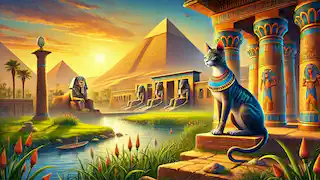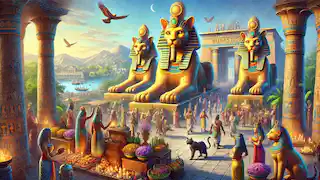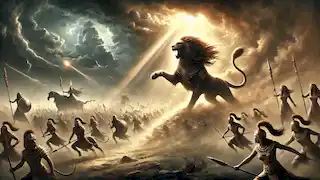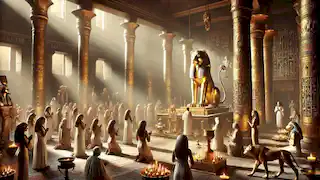The Story of Bastet
Reading Time: 8 min

About Story: The Story of Bastet is a Myth from egypt set in the Ancient. This Descriptive tale explores themes of Justice and is suitable for All Ages. It offers Cultural insights. The legendary tale of Egypt’s fierce yet nurturing goddess, Bastet.
In the ancient land of Egypt, where the sun scorched the sands by day and the Nile’s cool waters shimmered under the moonlight, there lived a goddess who walked among both the divine and mortal alike. Her name was Bastet. Revered as a protector, nurturer, and bringer of harmony, Bastet was not merely a deity of physical strength but also the embodiment of the balance between ferocity and grace. Her image has endured for millennia, her tales told in the shadows of great pyramids and whispered among the reeds along the Nile. Bastet’s origins trace back to the early days of Egyptian mythology when the gods shaped the world and its people. Born from the union of Ra, the great sun god, and Sekhmet, the lioness warrior goddess, Bastet was destined to possess both the power of her mother and the wisdom of her father. Unlike Sekhmet, who was known for her ferocity and wrath, Bastet grew to be a goddess of softer strength, the guardian of homes and families, and the protector against evil spirits and disease. Her image was one of duality. By day, she took the form of a lioness, a symbol of protection and war, guarding the pharaohs and temples. By night, she became a domesticated cat, representing warmth, love, and the calmness of hearth and home. Egyptians adored her, keeping cats in their homes as a reflection of the goddess's nurturing spirit. Yet Bastet’s role in the pantheon of gods was far from passive. As she grew in strength, she developed a reputation as the goddess who could both heal and destroy. With her sharp claws and keen eyes, she warded off malevolent forces, but with her gentle purrs, she brought comfort to those in need. Her relationship with the other gods was complex. While Ra saw in her the light and warmth of his lineage, Sekhmet regarded her daughter with an intensity that was equal parts pride and jealousy. It was said that Bastet’s capacity for both love and battle brought her closer to mortals than many of the other gods. As time passed, Bastet’s influence grew, and a grand temple was erected in her honor in the city of Bubastis, which became the spiritual center of her worship. Bubastis, nestled along the fertile banks of the Nile, was a vibrant city filled with traders, craftsmen, and priests who tended to the rituals of the goddess. It was here that Bastet’s presence was felt the strongest, where her temple stood as a monument to her dual nature. The annual festival of Bastet, celebrated at Bubastis, drew worshippers from every corner of Egypt. The festival was a grand affair, where Egyptians would gather along the river in boats adorned with flowers and offerings for the goddess. They played music, danced, and sang in her honor, believing that the joy and reverence they expressed would bring favor upon their homes and families. Bastet's priests were known for their deep knowledge of healing. Using herbs and ancient rites, they cured diseases, drove out evil spirits, and provided counsel to those in need. It was believed that Bastet herself guided their hands, especially in matters concerning childbirth and the protection of children. Women from all over Egypt came to Bubastis to seek blessings for fertility and healthy families. Despite her nurturing reputation, Bastet’s protective side was never far from the surface. When enemies threatened the peace of Egypt, the pharaohs invoked her name in battle. As a lioness, she became the spirit of war, guiding armies to victory and protecting the kingdom from invaders. She was a fierce guardian of order, and any who sought to disrupt the harmony she fostered were met with swift and divine retribution. The peace that Bastet had worked so hard to maintain was not always assured. Among the gods, there were those who envied her growing power, none more so than Set, the god of chaos and destruction. Set, who thrived on disorder, saw Bastet as a threat to his dominance. Her influence over the mortal realm, particularly in matters of justice and protection, was growing, and Set could not allow her to further disrupt his plans. A great conflict erupted between them, known as the War of the Gods. Set unleashed his forces of darkness upon the mortal world, seeking to spread chaos across the land. Rivers ran red with blood, and the skies darkened as storms and plagues ravaged the people. Bastet, alongside her mother Sekhmet and her father Ra, took up arms to defend Egypt. In battle, she became the lioness of legend, her roars shaking the very foundations of the heavens. Her armies, composed of both divine and mortal forces, fought fiercely against the tide of chaos that Set had unleashed. The battle raged for many months, and although Set was a formidable opponent, Bastet’s cunning and strength won the day. Using her knowledge of both healing and war, she devised a strategy that would not only weaken Set’s power but also restore balance to the world. She knew that Set thrived in darkness, and so, she called upon her father Ra to shine the light of the sun down upon the battlefield. The light pierced the veil of chaos, scattering Set’s forces and driving him back into the shadows. The victory was a decisive one, and Bastet’s reputation as a protector of the realm was cemented. But the war had taken its toll on the land. Famine and disease had spread, and it was up to Bastet to heal the wounds of both the world and its people. She worked tirelessly, bringing life back to the crops, healing the sick, and restoring order to the kingdom. Though Bastet had triumphed in battle, her duties as protector were far from over. The night was still a time of danger, and it was under the cover of darkness that malevolent forces still sought to harm the people of Egypt. Bastet took on a new role, becoming the Guardian of the Night. As a cat, she prowled the shadows, her keen eyes ever watchful for any sign of trouble. She became the protector of the home, watching over families as they slept. Cats, sacred to Bastet, were seen as her earthly representatives. They were allowed to roam freely through the streets and homes of Egypt, guarding against vermin and evil spirits alike. To harm a cat was to invite the wrath of Bastet herself, and many believed that cats carried a piece of the goddess within them. Her temple at Bubastis continued to grow in prominence, and offerings to Bastet poured in from all over Egypt. Gold, incense, and finely crafted statues were placed at her altar, and the people came to her in times of need, seeking her protection and guidance. In the eyes of the Egyptians, Bastet had become more than a goddess—she was a guardian, a healer, and a mother to all who called upon her. As the centuries passed, Egypt changed. Dynasties rose and fell, and the gods shifted in prominence. Yet Bastet remained a constant presence in the lives of the Egyptian people. Her temple at Bubastis stood as a symbol of her enduring power, and her festival continued to draw worshippers even in times of hardship. Even as the influence of Egypt began to wane and foreign powers came to dominate the land, Bastet’s name lived on. She became a symbol of resilience, a reminder that even in the face of chaos and change, the bonds of family and community could endure. Her legacy was one of balance—between strength and compassion, between war and peace, and between the divine and the mortal. Bastet’s story did not end with the fall of ancient Egypt. Her image, that of the lioness and the cat, persisted in art, literature, and popular culture. Today, she is remembered not only as a goddess of the ancient world but also as a symbol of protection, motherhood, and the enduring power of harmony. In modern times, Bastet's legacy has taken on new meanings. Her association with cats, both domesticated and wild, has been celebrated in various ways across the world. From statues and paintings to modern media, the image of Bastet continues to captivate the imagination of people from all cultures. Her fierce yet nurturing persona resonates with those who seek a protector that embodies both strength and gentleness. In the stories passed down through generations, Bastet remains a reminder that true power lies in balance. She teaches that love and protection are not separate from strength but are intertwined, that even in the face of chaos, one can find harmony. Her lessons endure, not just in the temples and artifacts of ancient Egypt, but in the hearts of those who continue to honor her memory.Birth of a Divine Protector

The Rise of Bubastis
The War of Gods

The Guardian of the Night
The Eternal Bastet

Legacy of the Lioness


















